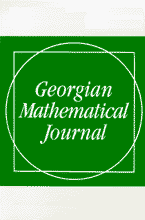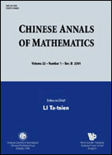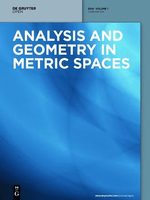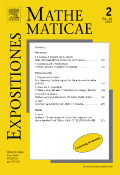
Annales Fennici Mathematici
Scope & Guideline
Advancing Mathematical Frontiers
Introduction
Aims and Scopes
- Metric Measure Spaces:
A significant focus is placed on the study of metric measure spaces, including Sobolev spaces and inequalities that arise in these contexts, reflecting a commitment to geometric analysis. - Functional Analysis and Operator Theory:
The journal frequently publishes articles on functional spaces, bounded operators, and their properties, showcasing the interplay between analysis and geometry. - Geometric Analysis:
There is a consistent emphasis on geometric properties of mathematical objects, such as minimal surfaces, geodesics, and the study of various geometric inequalities. - Nonlinear Partial Differential Equations (PDEs):
Research on nonlinear PDEs, particularly those with critical growth conditions, is prevalent, indicating the journal's role in advancing the understanding of these complex equations. - Complex Analysis and Quasiconformal Mappings:
The exploration of complex analysis, including quasiconformal mappings and harmonic functions, highlights the journal's dedication to foundational aspects of analysis. - Fractal Geometry and Dimension Theory:
The journal also covers topics related to fractal geometry, Hausdorff dimension, and self-similar sets, underscoring its commitment to studying complex geometric structures.
Trending and Emerging
- Metric Geometry and Analysis:
There is a growing interest in metric geometry, particularly in the analysis of metric measure spaces and their applications to various inequalities and geometric properties. - Fractional Differential Equations:
The exploration of fractional differential equations and inequalities has become increasingly prominent, indicating a trend towards studying nonlocal phenomena in mathematical analysis. - Geometric Measure Theory:
Emerging themes in geometric measure theory, including the study of minimal surfaces and the properties of various dimensions, reflect an expanding interest in the geometric aspects of analysis. - Applications of Functional Analysis:
The application of functional analysis to solve problems in different mathematical contexts is on the rise, showcasing an interdisciplinary approach to modern mathematical challenges. - Advanced Techniques in PDEs:
Recent works highlight advanced techniques in the study of nonlinear PDEs, particularly those addressing critical growth and variational methods, indicating a shift towards more sophisticated analytical tools.
Declining or Waning
- Elementary Number Theory:
There has been a noticeable decline in papers specifically focusing on elementary number theory, suggesting a shift towards more complex and abstract areas of research. - Classical Geometry:
Traditional aspects of classical geometry, such as Euclidean constructions and basic geometric properties, seem to be receiving less attention, possibly overshadowed by more contemporary geometric analysis. - Probabilistic Methods in Analysis:
Research related to probabilistic methods or stochastic processes appears to be less prevalent, indicating a waning interest in this intersection of probability and analysis.
Similar Journals

Georgian Mathematical Journal
Exploring the depths of mathematics for global impact.Georgian Mathematical Journal, published by Walter de Gruyter GmbH, is a prestigious academic journal dedicated to the field of mathematics, particularly in its multifaceted applications and theoretical explorations. With an ISSN of 1072-947X and an E-ISSN of 1572-9176, this journal is indexed within notable databases and holds a strong position as evidenced by its Q2 ranking in the Mathematics (miscellaneous) category as of 2023 and a ranking of #140 out of 399 in the general mathematics Scopus category, placing it in the 65th percentile for research visibility. Since its inception in 1994, the journal has continued to evolve, aiming to foster innovative research and scholarly communication among mathematicians worldwide. Although it does not offer Open Access, the journal’s commitment to quality and rigor ensures that published works are of high relevance, appealing to researchers, educators, and students who are dedicated to advancing mathematical knowledge across diverse domains.

CHINESE ANNALS OF MATHEMATICS SERIES B
Exploring Innovative Theories in MathematicsCHINESE ANNALS OF MATHEMATICS SERIES B, published by Shanghai Scientific Technology Literature Publishing House, is a prominent journal dedicated to fostering research and development in the field of mathematics. With an ISSN of 0252-9599 and an E-ISSN of 1860-6261, this journal provides a platform for the dissemination of innovative mathematical theories and methodologies. As of 2023, it is categorized within the Q4 quartile in *Applied Mathematics* and has achieved a commendable Q3 rank in *Mathematics (miscellaneous)*, emphasizing its growing influence in academia. Despite not being an open-access publication, it serves as a valuable resource for researchers, professionals, and students seeking to explore diverse mathematical topics, particularly from a unique regional perspective. The journal's extensive publication history—from 1980 and continuing to 2024—demonstrates a longstanding commitment to advancing mathematical knowledge and providing insights into various disciplines related to mathematics.

ANNALI DI MATEMATICA PURA ED APPLICATA
Exploring the Boundaries of Applied MathematicsANNALI DI MATEMATICA PURA ED APPLICATA is a prestigious journal published by Springer Heidelberg, focusing on the field of Applied Mathematics. With a rich history dating back to its initial publication stages from 1858, this journal continues to serve as a vital platform for researchers and professionals seeking to disseminate high-quality, peer-reviewed research. The journal's strong reputation is reflected in its Q1 ranking in Applied Mathematics and its Scopus rank of #335 out of 635, placing it in the 47th percentile, showcasing its impact in the field. Although it is not an open-access journal, it provides exclusive insights and advancements in mathematical applications, allowing academics to explore innovative methodologies and theoretical developments. The combination of its long-standing tradition and contemporary relevance makes ANNALI DI MATEMATICA PURA ED APPLICATA an essential resource for scholars and students looking to deepen their understanding of mathematics and its practical applications.

Advances in Operator Theory
Illuminating Complexities in Operator TheoryAdvances in Operator Theory is a premier journal dedicated to the exploration of innovative and foundational research within the disciplines of Algebra and Number Theory, as well as Analysis. Published by SPRINGER BASEL AG, this journal provides a vital platform for the dissemination of high-quality research and theoretical advancements in the realm of operator theory. With a commendable impact factor and categorized in the Q3 quartile for both Algebra and Number Theory and Analysis in 2023, it holds significant standing in the Scopus rankings, substantiating its relevance in the mathematical community. The journal encourages open discussions and lively exchange of ideas among researchers, professionals, and students alike, fostering an environment conducive to scholarly growth and collaboration. Based in Iran at PICASSOPLATZ 4, BASEL 4052, SWITZERLAND, it has been actively publishing since 2016, making substantial contributions to its field through rigorous peer-reviewed articles. As an essential resource for anyone invested in the forefront of mathematical research, Advances in Operator Theory continues to illuminate complex topics and inspire future inquiries.

Analysis and Geometry in Metric Spaces
Elevating mathematical scholarship with open-access insights.Analysis and Geometry in Metric Spaces is a distinguished open-access journal published by DE GRUYTER POLAND SP Z O O, dedicated to advancing the fields of analysis, geometry, and applied mathematics. Since its inception in 2013, the journal has established itself as a vital resource for researchers and practitioners, consistently achieving high rankings in its categories, including Q1 in Analysis and Q2 in Applied Mathematics and Geometry and Topology, with notable Scopus rankings reflecting its impact within the mathematical community. The journal aims to foster scholarly exchange by publishing rigorous research articles that explore innovative trends and significant developments in metric space theory. With continuous open-access accessibility, it ensures that the latest findings are readily available to academics across the globe, thus contributing to the broader discourse within mathematics. As the journal prepares to bridge the years to 2024, it remains committed to serving as a cornerstone for advancements in its scope and a beacon for methodological breakthroughs.

Space
Exploring the Nexus of Art and ArchitectureSpace is a distinguished journal within the realms of Visual Arts and Architecture, published by the reputable SPACE MAGAZINE. Although its coverage in major indexing databases such as Scopus has ceased since 2016, the journal played a significant role from its inception in 2008, contributing valuable insights during its publication years. Featuring a broad interdisciplinary approach, Space explored the intersections of artistic and architectural expression, offering a platform for researchers and practitioners to exchange innovative ideas. The journal's impact within the field of Arts and Humanities is reflected in its Scopus rankings, where it holds significant positions, albeit with lower percentiles, in both relevant categories. Although it currently does not offer open access, the journal remains a reference point for scholars interested in the evolving dynamics of space in the arts. As such, Space continues to be an essential resource for individuals who strive to understand and explore the relationship between human creativity and spatial design.

Complex Analysis and Operator Theory
Exploring the Depths of Complex TheoryComplex Analysis and Operator Theory, published by Springer Basel AG, is a renowned journal in the field of applied and computational mathematics, reflecting a strong engagement with contemporary mathematical challenges. With an ISSN of 1661-8254 and E-ISSN 1661-8262, this journal provides a platform for disseminating significant findings and innovative methodologies that contribute to the advancement of complex analysis, operator theory, and their diverse applications. As a valuable resource for researchers and practitioners alike, it features high-quality peer-reviewed articles that rigorously explore both theoretical and practical aspects of mathematics. Although it currently does not offer open access, readers can access its insightful content through institutional subscriptions or individual purchases. Since its inception in 2007, the journal has carved a niche for itself, evidenced by its placement in the Q2 quartiles in both Applied Mathematics and Computational Mathematics, and its recognition in Computational Theory and Mathematics. With an ambitious goal to foster the dialogue between theory and practice, Complex Analysis and Operator Theory continues to support the mathematical community from its base in Basel, Switzerland.

PUBLICATIONES MATHEMATICAE DEBRECEN
Bridging Theory and Application in MathematicsPublicationes Mathematicae Debrecen is a renowned international journal published by the University of Debrecen, Institute of Mathematics, situated in Hungary. This journal, with both ISSN 0033-3883 and E-ISSN 2064-2849, has established itself in the field of mathematics since its inception, with coverage extending from 1997 to 2024. Recognized for its rigorous academic standards, it currently holds a Q3 ranking in the mathematics (miscellaneous) category for 2023 and ranks at the 42nd percentile among general mathematics journals in Scopus. Publicationes Mathematicae Debrecen aims to disseminate high-quality research across various areas of mathematics, contributing to the advancement of knowledge and practice in this dynamic field. Although it is not an open-access journal, its readers can access a wealth of scholarly work that addresses both theoretical and applied mathematical issues, making it an invaluable resource for researchers, professionals, and students alike.

EXPOSITIONES MATHEMATICAE
Fostering Original Research in Diverse Mathematical FieldsEXPOSITIONES MATHEMATICAE, published by Elsevier GmbH, stands as a significant journal in the realm of mathematics, catering primarily to researchers, professionals, and students. With an ISSN of 0723-0869 and an E-ISSN of 1878-0792, this journal has made its mark in the academic community, boasting a Q2 classification in the miscellaneous mathematics category for 2023, illustrating its prominence within its field. The journal addresses a diverse scope of mathematical topics, encouraging the publication of original research and innovative theories while maintaining rigorous academic standards. As it converges from 2004 to 2024, EXPOSITIONES MATHEMATICAE continues to be an essential resource for advancing mathematical knowledge and fostering scholarly communication, despite being a non-open-access publication. Its location in Munich, Germany further anchors it within a rich intellectual tradition, providing accessibility for the mathematical community worldwide.

Journal of Mathematical Analysis
Exploring New Dimensions in Mathematical AnalysisThe Journal of Mathematical Analysis, published by UNIV PRISHTINES in Serbia, offers a dedicated platform for the dissemination of innovative research in the fields of mathematical analysis and applied mathematics. With an ISSN of 2217-3412 and a convergence period from 2020 to 2024, this journal aims to foster significant advancements in both theoretical and practical aspects of mathematics. Categorized in the Q4 quartile for Analysis, Applied Mathematics, and miscellaneous Mathematics as of 2023, it serves as an essential resource for researchers and professionals alike, providing key insights into the evolving landscape of mathematical inquiry. Although it is an open access journal, facilitating global readership, its Scopus rankings reflect its emerging status, with rankings indicating a 51st percentile in Mathematics (miscellaneous) and 28th percentile in Applied Mathematics. This journal not only aims to contribute to academic discourse but also seeks to bridge gaps between mathematical theory and real-world applications, making it a vital resource for students and professionals engaged in the complexities of mathematical research.